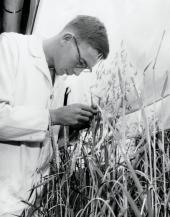

Douglas Knott, born on November 10, 1927, in New Westminster, British Columbia, obtained a Bachelor of Science in Agriculture from the University of British Columbia in 1948, followed by a Master’s and a PhD from the University of Wisconsin in 1952, specializing in plant genetics. That same year, Knott joined the University of Saskatchewan Department of Field Husbandry. From 1965 to 1975 he was Head of the Crop Sciences Department; he served as Acting Dean of Agriculture in 1979 and again in 1989; and he was Associate Dean of Research from 1988 to 1993. In 1986 he was named as the first holder of the W.J. White Chair in Crop Science. He was instrumental in developing the Crop Development Centre at the University of Saskatchewan. Knott became an internationally recognized expert in wheat stem and leaf rust resistance. He developed methods for identifying genes that can be used in breeding rust resistant wheats, and an innovative way to transfer genes from wild wheats to domesticated varieties. His book, The Wheat Rusts: Breeding for Resistance, is highly regarded by specialists.
Knott also developed several varieties of durum: Stewart 63 durum in 1963; Arcola in 1983; Sceptre in 1985; and Plenty in 1990. Knott was a Fellow of the American Society of Agronomy, the Crop Science Society of America, and the Agricultural Institute of Canada; he received an honorary life membership in the Canadian Seed Growers Association. His skills were in demand internationally: he was wheat research director for the Zambia-Canada Project from 1983 to 1988, and was a research consultant and lecturer in Brazil, China, and Kenya. Knott served as president of the Saskatchewan Institute of Agrologists from 1958 to 1959, and as honorary secretary of the SIA from 1970 to 1974. In 1995 he was inducted into the Saskatchewan Agricultural Hall of Fame, and in 1999 was appointed a Member of the Order of Canada for his contributions to agricultural science. Douglas Ronald Knott passed away on June 5, 2009; a memorial fund in his name has been established at the Saskatoon Community Foundation.
Canadian Plains Research Center